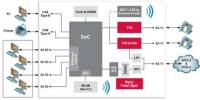A DC-to-DC converter is an electrical or electromechanical device that transforms direct current (DC) from one voltage level to another. Depending on the design and application needs, this conversion can be step-up (boost), step-down (buck), or a combination of the two. It’s a form of electrical power converter. Power levels range from very low (tiny batteries) to extremely high (high-voltage power transmission).
DC-to-DC converters are widely employed in electronic devices and systems where the available voltage must be modified to meet the needs of specific components or subsystems. For example, they are commonly employed in battery-powered gadgets such as cellphones, laptops, and portable electronics to efficiently regulate the voltage from the battery to power the internal components.
There are several types of DC-to-DC converters, including:
- Buck Converter: This type of converter steps down the input voltage to a lower output voltage. It is commonly used in applications where the output voltage needs to be lower than the input voltage, such as in power supplies for microcontrollers, sensors, and other low-voltage devices.
- Boost Converter: A boost converter increases the input voltage to a higher output voltage. It is often used in applications where the input voltage is lower than the required output voltage, such as in LED drivers and battery chargers.
- Buck-Boost Converter: This type of converter can step up or step down the input voltage to maintain a constant output voltage. It is useful in applications where the input voltage can vary significantly, such as in automotive electronics and renewable energy systems.
- Flyback Converter: The flyback converter is a type of isolated DC-to-DC converter that stores energy in an inductor during the switch-on time and releases it to the load during the switch-off time. It is commonly used in low-power applications, such as battery chargers and LED drivers.
- Forward Converter: Similar to the flyback converter, the forward converter is also an isolated DC-to-DC converter but operates with a transformer in a continuous mode. It is often used in medium to high-power applications, such as in telecommunications equipment and industrial power supplies.
Applications
DC-to-DC converters are commonly used in portable electronic devices such as cell phones and laptop computers, which are powered mostly by batteries. Such electrical devices sometimes include multiple sub-circuits, each with a voltage level demand that differs from that supplied by the battery or an external supply. Furthermore, the battery’s voltage drops when its stored energy is depleted. Instead of requiring many batteries to achieve the same result, switched DC-to-DC converters provide a technique of increasing voltage from a partially reduced battery voltage, saving space.
DC-to-DC converters are critical components in modern electronics because they allow for efficient power management and voltage regulation, increasing battery life, boosting system performance, and lowering overall power consumption.
















